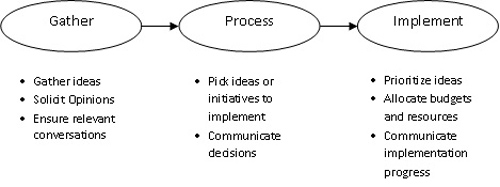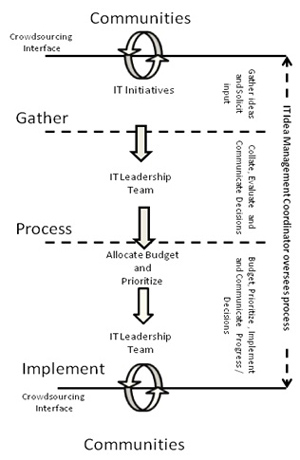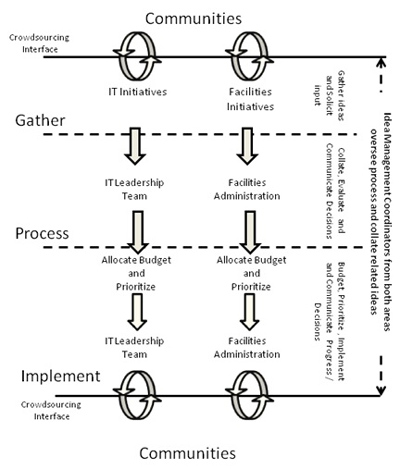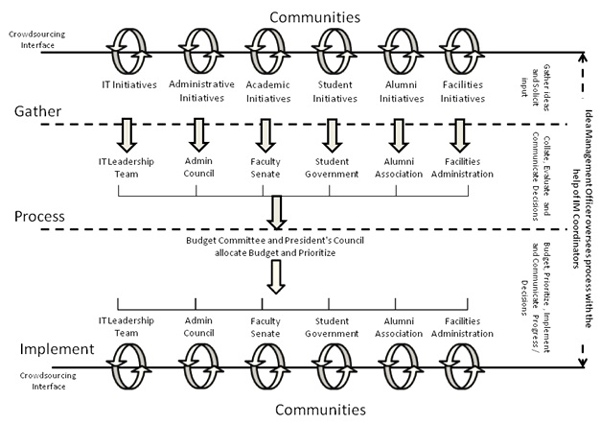Key Takeaways
- Crowdsourcing can provide valuable feedback on allocating scarce resources while meeting community needs for IT services.
- Monitoring the contributions of ideas and managing expectations are key to successful crowdsourcing implementations.
- A three-phase implementation lets a crowdsourcing initiative start with low costs and grow as momentum builds.
- Following successful implementation of crowdsourced ideas, the IT department can collaborate with other organizations on campus to extend the concept and foster wider participation across the institution.
As an idea management tool, crowdsourcing has made little headway at institutions of higher education. Yet this age of doing more with less calls for exactly what crowdsourcing has to offer: a quick, relatively inexpensive way to tap into the resources and opinions of a committed community.
What Is Crowdsourcing?
Although there are several definitions for crowdsourcing, here I define it as the process of continual idea-based problem solving by communities with the intent of improving a product or service in which they have a vested interest.
Why Crowdsourcing?
The challenge of allocating scarce resources to maximize benefits has become harder than before with the downturn in the economy and ensuing budget cuts. IT staffs, in particular, must do more with less, rolling out solutions quickly while maintaining or improving quality of service. In this struggle for efficiencies, IT risks allocating resources to initiatives that might not give the institution the biggest bang for its buck. Crowdsourcing can help with some of the tough choices institutions are facing today, in the following ways:
- Prioritizing scarce resources. Crowdsourcing can help determine which initiatives users value most, letting institutions prioritize budgets and resources for these initiatives.
- Increasing collaborative innovation. Collective problem solving can lead to innovations or new ideas that might not be possible when confined to a small group or an individual.
- Accessing a larger talent pool (collective intelligence) for problem solving. Crowdsourcing lets an institution access previously inaccessible intellectual capital. For example, it provides a forum for any employee or student to present her ideas (and problem-solving abilities) in front of an entire community, whereas these ideas are frequently lost in translation when transmitted through traditional institutional channels.
- Ongoing external scan for strategic planning. Crowdsourcing allows for continual engagement of communities and can be a valuable source for continual external scans for strategic planning.
- Strengthening the sense of community. Crowdsourcing can create a collaborative environment that reinforces a strong sense of community.
Understanding the Environment
A typical higher education institution has several communities:
- Students
- Faculty
- Staff
- Alumni
- Retirees
The first three are active participants in the daily functioning of the institution. They can provide valuable insight into inefficiencies in services. On the other hand, alumni and retirees are comparatively passive participants who support the institution for emotional reasons. Their support typically is either financial or advisory. These two communities can provide an outsider's perspective to an institution, especially with respect to its perceived image. Knowing and engaging all of these communities is critical for the successful implementation of idea management.
Multiple Campuses
Crowdsourcing can present even more of a challenge at an institution with multiple campuses — especially when those campuses are in different parts of a state or country. Such campuses can have varying degrees of autonomy, depending on the institution's policies and the unique campus cultures. Opening up a crowdsourcing platform to communities that might have disparate preferences can create additional challenges. At the same time, it can create tremendous opportunities to explore a common solution to an issue that affects all campuses.
The Process of Idea Management
In crowdsourcing, there are three steps to managing and implementing ideas, as Figure 1 shows.

Figure 1. Three Crowdsourcing Steps
1. Gather
The first step is to gather ideas and then publish them for public opinion. This requires solicitation of new ideas on an ongoing basis or at key points in time. Ongoing solicitation is the best, but requires dedicated resources. Solicitation at a point in time invites the risk of losing ideas — people might forget or loose interest in communicating their ideas if they can't do so immediately. The downside to immediate communication is that contributors might not have vetted or thought through their ideas.
Another important consideration is whether the institution should filter ideas before publishing them for public opinion. Too many bad ideas can discourage participation, but filtering ideas can raise important questions about the system's fairness and freedom of speech.
Public or community opinion is another key aspect of gathering ideas. Opinions must be visible to encourage healthy dialogue. But, monitoring opinions and managing them — that is, discouraging those that are out of line or out of context — is important to keeping the conversation relevant.
2. Process
The second step is processing the submitted ideas and the associated public comments. Processing involves deciding which ideas are popular enough to implement or are possible to implement. For example, a great idea can be beyond the institution's resources. In that case, the institution might have to choose an idea that has less popular support but is within its resources.
Another key aspect of processing ideas is communicating the reason for choosing an idea for implementation. Transparency is necessary for crowdsourcing to work.
3. Implement
Implementation requires the dedication of an institution's resources. An idea or a group of ideas chosen for implementation might conflict with the institution's current priorities. The implementation process establishes the priority and the scope of the implementation, and allocates budget and other resources.
As with the process step, it is very important to communicate the progress of the implementation to build confidence in the process. This also conveys the institution's commitment to better serving its communities.
Implementing Crowdsourcing
As a central service organization, the campus IT organization is best suited to incubate and nurture the crowdsourcing effort. The demands on IT organizations have increased because budgets are declining while departments demand more help to automate business processes. Today collaboration (to reduce costs) and resource prioritization have assumed more importance than in the past. Although there are several uses for crowdsourcing, this section concentrates primarily on the process of going from idea to implementation using crowdsourcing.
I recommend a phased approach to implementing crowdsourcing; advantages include:
- Low initial cost with minimal strain on budgets
- Gradual accumulation of knowledge capital to support a systemic process
- A process that scales, depending on need and resources
- A gradual ironing out of process deficiencies
It's possible to implement crowdsourcing in three phases. Depending on the success of the implementation within a phase, an organization can choose to implement the next phase.
Phase 1: Pilot Within IT
Phase 1 lays out the foundation for the crowdsourcing platform. Initiatives within the IT organization itself make ideal candidates for the initial use of crowdsourcing. Figure 2 shows how the three steps apply to a pilot within IT.

Figure 2. Crowdsourcing as an IT Initiative
- Establish scope. First, decide the focus or scope of the crowdsourcing implementation. The following gives three categories of use along with examples:
- Solicit any idea for implementation (open innovation). For example, IT could ask "How can we improve student labs?" but the community might respond saying, "Instead of labs, improve wireless connectivity on campus and let students check out laptops."
- Solicit input on current initiatives (prioritization by popularity). In this case, IT might ask, "Given a choice, should we implement a new learning management system or replace existing classroom technology?"
- Let communities actively solve issues themselves. These issues include some that IT traditionally solves itself. For example, communities could use crowdsourcing to provide helpdesk services.
- Appoint an IT idea management coordinator. Initially, the coordinator can be an existing employee from client services, planning, or project management. Depending on the success of crowdsourcing, this position can become permanent. The main responsibilities of the idea management coordinator are to:
- Oversee the process of implementation.
- Enforce the crowdsourcing procedures set up by the organization.
- Communicate expectations to the communities.
- Collate the ideas collected through crowdsourcing into an idea portfolio.
- Train other staff, if needed.
- Obtain software. Invest in open-source software, such as Best Buy Idea Exchange, to minimize the initial cost of implementation. If the organization finds sufficient value in crowdsourcing, it can introduce commercial platforms later. Technology should not be the limiting factor in gathering ideas; the organization should also promote low-tech solutions such as idea boxes. The idea management coordinator can input ideas submitted via the boxes into the online crowdsourcing platform.
- Set procedures and expectations. This is a key step that makes idea generation topical and relevant, sets the tone for conversations, and clearly outlines the idea selection and implementation process. For example, it is very important to set the expectation that the organization cannot implement all ideas because of resource constraints. Another important item to consider is the intellectual property rights for any innovation that might result from crowdsourcing.
- Market the effort. Once the organization determines the scope and target audience, defines the procedures, and has the technical solution in place, conduct a marketing campaign to inform communities of the new crowdsourcing initiative.
- Write training materials. Training materials will instruct communities on the procedures and etiquette of using the crowdsourcing platform.
- Foster participation. If possible, provide incentives for participation. For example, negotiate with faculty to grant students extra credit for submitting ideas that the organization selects for implementation. For employees, see whether it's possible to give bonuses for an idea selected.
- Get feedback from IT leadership. As the crowdsourcing platform collects ideas and solicited opinions, the idea management coordinator should present the idea portfolio to the IT leadership team. The team determines the viability of the ideas and discusses the feedback from the communities. In the first phase, the IT leadership team also selects ideas for implementation based on available budgets. This group also prioritizes the selected ideas.
- Communicate with the community. At every stage, the idea management coordinator should communicate back to the community, explaining decisions and the reasoning behind them. At the idea implementation stage, the coordinator should provide the community with regular updates.
Phase 2: Partner with Another CSO
Once the IT organization is comfortable with the crowdsourcing processes, it can partner with another central service organization (facilities, for example) that is similar to the IT organization and willing to use the existing crowdsourcing platform and process. Figure 3 shows this process.

Figure 3. Adding a Partner to the Crowdsourcing Initiative
The idea management coordinators for the two departments collaborate to identify any overlapping initiatives. The purpose of the second phase is threefold:
- Provide a good testbed to determine whether crowdsourcing will work for non-IT initiatives.
- Iron out any intradepartmental collaboration issues concerning idea management.
- Adjust the process or platform for any special needs of the partnering department.
Following successful collaboration and implementation of ideas, the two organizations can then partner with additional organizations on campus.
Phase 3: Expand to Other Areas of the Institution
Once a critical mass of organizations is actively using the crowdsourcing platform, the institution can hire an idea management officer, who will have the following responsibilities:
- Own the crowdsourcing and idea management process.
- Collate the numerous idea portfolios into a single institutional idea portfolio.
- Identify areas of collaboration and encourage it.
- Identify innovation opportunities based on the portfolio.
The final stage involves elevating the budgeting function from an organizational level to an institutional level, as shown in Figure 4. The institution now uses the institutional idea portfolio as input to the overall budgeting process.

Figure 4. Crowdsourcing as an Institution-Level Initiative
Conclusion
With budget cuts and increased demand for IT services, effective collaboration and allocation of scarce resources have assumed more importance than before. It is in the vested interest of IT organizations to take the lead in introducing crowdsourcing to their respective institutions, making sure that the process yields successful implementations of ideas. With incremental steps, IT organizations can foster communities that consume as well as improve IT services. In doing so, the IT organization and its parent institution can take advantage of a better way to stay in touch with the needs of their communities.
© 2011 Pankaj Sharma. The text of this article is licensed under the Creative Commons Attribution 3.0 license.
